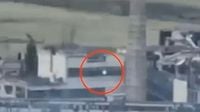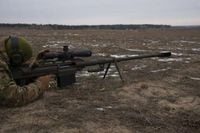On August 14, 2025, the relentless conflict in eastern Ukraine produced a moment that stunned military observers and set a new benchmark for long-range marksmanship. In the embattled Pokrovsk sector, a Ukrainian sniper from the special unit Pryvyd—also known as the “Ghost” combined sniper unit—eliminated two Russian soldiers with a single shot from an astonishing distance of 4,000 meters. The feat, confirmed by multiple sources including Defense Express, Kyiv Post, and military journalist Yuriy Butusov, now stands as the longest confirmed sniper kill in history.
But this was no ordinary shot. According to Butusov, who released video footage of the event, "Incredible accuracy and a new world record for long-distance engagement! A Ukrainian sniper neutralized two Russian servicemen from 4,000 meters. The bullet hit through a window where the occupiers were positioned." The shot was made possible by a combination of advanced technology and battlefield ingenuity: targeting was assisted by artificial intelligence (AI) and real-time drone support, a testament to how modern warfare is increasingly shaped by digital tools as much as steel and gunpowder.
The sniper wielded the Snipex Alligator rifle, a formidable anti-material weapon produced by Kharkiv-based XADO-Holding. This rifle, chambered in 14.5 mm and weighing in at 25 kilograms (about 55 pounds), is no stranger to the Ukrainian arsenal. It features a barrel length of 1,200 mm and can fire bullets at a muzzle velocity of 980–1,000 meters per second. While the manufacturer originally rated its effective range at 2,000 meters, the Alligator’s bullet is theoretically capable of traveling up to 7,000 meters—though, as experts from Defense Express point out, accuracy becomes a significant limiting factor at such extreme distances.
To put the challenge in perspective: at 1.5 kilometers, the bullet’s deviation from the point of aim can already form a circle roughly one meter in diameter. At 4 kilometers, hitting a human-sized target requires a blend of technical mastery, environmental calculation, and, perhaps, a touch of luck. As Defense Express observed, “At a distance of 4 km, it likely took a series of shots to achieve an accurate hit.”
The shot itself was executed in the Pokrovsk-Myrnohrad direction—a sector that has seen intense fighting, with Russian forces estimated at around 110,000 troops in the area and recent breaches of Ukrainian defensive lines. Despite the pressure, the Ukrainian military has maintained that the situation remains under control.
The Alligator rifle, while originally designed as an anti-material weapon to destroy fortifications and lightly armored vehicles, has repeatedly proven its versatility on the battlefield. As Defense Express noted, “Real-life experience has shown not only completely different requirements, but also the actual capabilities of Ukrainian weapons, which have far exceeded their creators’ expectations.” In this case, the rifle’s power was brought to bear on enemy personnel with unprecedented precision.
This world record is not an isolated achievement but part of a broader trend in Ukraine’s military evolution. The previous record for the longest confirmed sniper kill also belonged to a Ukrainian. In November 2023, 58-year-old Vyacheslav Kovalsky of the Security Service of Ukraine (SBU) eliminated a Russian soldier at 3,800 meters in Kherson, using a domestically produced multi-caliber sniper rifle known as the “Lord of the Horizon.” Earlier still, a sniper from Ukraine’s Military Intelligence, call sign “Lektor,” made history with a 2,069-meter confirmed kill using a 338 Lapua Magnum-caliber rifle.
Sniping has become a highly developed skill within the Ukrainian armed forces, especially since the outbreak of hostilities in 2014. Charitable foundations, domestic arms manufacturers, and a growing pool of military experience have all contributed to the development of specialized sniper and marksman rifles, as well as advanced ammunition and optics. The use of reconnaissance drones—particularly those equipped with thermal imaging—has presented both challenges and opportunities, pushing Ukrainian snipers to adopt new tactics for long-range engagements and to integrate technology such as AI-assisted targeting into their operations.
The Ghost sniper unit, which carried out the 4,000-meter shot, has become legendary in its own right. Over the past year, this unit has reportedly eliminated nearly 1,000 Russian soldiers in the Pokrovsk-Myrnohrad direction alone, according to UATV. Their success is emblematic of how Ukraine’s defense increasingly relies on small, highly trained teams capable of leveraging both their marksmanship and cutting-edge technology to punch above their weight on the battlefield.
But what does it take to make such a shot? In an exclusive interview with Kyiv Post, the sniper known as “Lektor” described the intense preparation and mental focus required for long-range engagements. From evading enemy drones to making split-second calculations about wind, distance, and bullet drop, the margin for error is razor-thin. “You have to be calm, almost detached,” he explained, “and trust your training. Every variable matters.”
The rapid pace of weapons development in Ukraine has been driven in part by necessity. With the front lines in constant flux and Russian forces deploying overwhelming numbers, Ukrainian engineers and manufacturers have had to innovate quickly. The Snipex Alligator is a product of this pressure-cooker environment—a rifle that, while originally intended for anti-material use, has become a symbol of Ukrainian resilience and ingenuity.
Of course, the human cost of these technological advances is never far from mind. The Pokrovsk sector, where the record shot was made, has witnessed some of the most intense fighting of the war, with both sides suffering heavy casualties. The presence of nearly 110,000 Russian troops underscores the scale of the conflict and the stakes involved for Ukraine’s defenders.
While the 4,000-meter shot is celebrated as a triumph of skill and technology, it also highlights the grim realities of modern warfare. Extreme-range sniping, once the stuff of legend, has become a practical tool in the arsenal of countries fighting for their survival. The integration of AI and drones into targeting processes signals a future where the boundaries of what’s possible on the battlefield will continue to be pushed—sometimes with deadly consequences.
As Ukraine’s snipers continue to set records and redefine the limits of their craft, their feats are watched closely by militaries around the world. The lessons learned on the front lines of Pokrovsk may well shape the next generation of long-range marksmanship, not just in Ukraine, but wherever soldiers are called to make the impossible shot.
For now, the record stands—a testament to Ukrainian innovation, determination, and the extraordinary demands of a war that shows no sign of abating.

